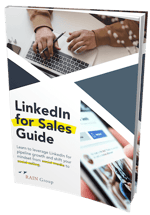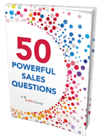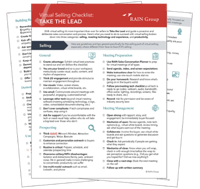Wouldn’t it be great if there was a silver bullet that would make you more successful in your sales efforts? Or if there was one thing you could do to really boost your sales results?
Here’s the bad news: there’s no silver bullet. Sales success takes hard work and commitment, along with skill and savvy. There’s no shortcut to success. But while there isn’t one thing that’ll magically transform your sales ability, there are many (mostly simple) things you can do to help boost your overall sales performance.
As you start thinking about your upcoming sales goals, use these 66 tips as a roadmap to your success.
- 11 Sales Tips for New Sellers
- 5 Sales Tips for Virtual Selling
- 9 Sales Tips for Building Rapport
- 5 Sales Tips for Needs Discovery
- 6 Sales Tips for Prospecting
- 3 Sales Tips for Qualifying Opportunities
- 6 Sales Tips for Making a Strong Case for Change
- 11 Sales Tips for Proposal Presentations
- 10 Sales Tips for Advanced Selling
11 Sales Tips for New Sellers
-
Sell solutions
Mediocre sellers sell features: “My product has 10 times more features than the competition and we’re half the price.”
Average sellers sell benefits: “Our product will save you days of time sifting through piles of data.”
Top performers sell specific solutions to specific challenges: “From our conversations, I understand A, B, and C are going on in your organization. If you can alleviate C, you’ll realize an immediate savings of more than $200,000 and more than $1.5 million in cost reduction annually. It'll also free up your staff to spend their time on more productive activities.”
-
Manage your time
It typically takes just as much time to seal a $25,000 deal as it does to sell a $100,000 deal (or whatever the equivalent is for us). Why not invest your time in getting more of the larger deals? Focus on bigger fish in your nurturing and prospecting efforts.
-
Keep prospecting
You’ve heard the ABCs of selling: Always Be Closing. But just as important is ABP: Always Be Prospecting. The best way to get over a lost sale is to move onto the next sale in your pipeline. If your pipeline is empty, it’s much more difficult to recover. Top performers are always working to fill the front end of their pipelines by creating new conversations every day.
For prospecting tips, read Sales Prospecting: Tips, Techniques, and Strategies.
-
Focus on quality, not quantity
To some degree, sales is a numbers game. But it’s not just about the numbers. The key is to create quality conversations.
The best sellers have strict qualification criteria and don’t waste their time with prospects who aren’t at the right level, companies that aren’t the right fit, or buyers who don’t have the funds to spend. Top performers work hard to learn this information early on so they don’t spend their precious time on prospects who aren’t going to go anywhere.
-
Plan and secure your next step
Never leave a meeting or a conversation without a solid next step that’s been agreed upon. Otherwise, you risk the buyer going silent and not returning your calls or emails. Instead, schedule the next step on the spot.
If the next step is to send a proposal, let them know you’ll put a proposal together, but you need to schedule a time during which you can walk them through it. When a buyer makes a commitment on the spot (putting the next meeting on their calendar), they’re much more likely to follow through.
-
Shoot high
It’s much more difficult to work your way up in an organization than it is to get referred down. When you start low it’s an uphill battle that’s rarely won. When you start high, however—at the C-suite—and get referred down, you’re more likely to find the right decision maker. And that person is more willing to take your call. After all, you’re being referred to them by the powers that be.
-
Be prepared
There’s no excuse for not doing your research before a sales meeting. Gather information from the buyer by asking them to respond to a few questions sent in an email or survey so you can make customized recommendations for their situation. Review their LinkedIn profile, read news articles about the company, or scan their annual report.
If you’re doing a demo, getting information in a pre-call or email allows you to create a demo geared exactly for what the buyer’s looking to do. By doing your research and asking the right questions ahead of time, you can deliver a high-impact experience.
For more ideas, view our Sales Call Planning Guide.
-
Provide value
Buyers want to work with people who are experts in their field and can provide value in each and every conversation.
What value can you provide, not only once a buyer buys from you, but in your conversations leading up to the sale?
-
Understand your buyers
RAIN Group’s 6 buyer personas walk you through the preferences and styles of different buyers. It’s essential to understand what’s important to each individual buyer and their decision-making process.
When you know this, you can more easily match your selling process to the buying process and ultimately win more deals.
-
Answer the "why?” questions
In all your communications and conversations, a series of why questions are circling around your buyers’ minds. Specifically, there are four whys you need to answer for buyers:
- Why act? Why do I need your product or service?
- Why now? Why should I stop what I am doing to listen to you?
- Why us? Why is your product or service better than the competition?
- Why trust? Why should I believe you?
By being proactive and addressing these four whys, you build a strong value proposition for why they should buy—now—from you.
-
Share stories
Case studies can be critically important in helping you close the sale. Use previous customer examples—anonymized or in aggregate if the data is sensitive or proprietary—to illustrate the positive impact of your product or service. Showing similar impact through case studies and stories builds credibility and belief you’ll deliver what you say you can. The stronger you can make your case, the more likely it is that you’ll close the sale.
5 Sales Tips for Virtual Selling
-
Create your virtual advantage
When you’re selling virtually, every element of the interaction contributes to or detracts from the buyer’s experience. This means you must carefully orchestrate the entire experience, from selling to technology.
Using visuals, audio, and content—such as video, screen shares, screen annotation, and virtual whiteboards—effectively will create an engaging experience for buyers and help you gain a virtual advantage over other sellers.
-
Turn video on
You might decide not to be on-camera for all your internal meetings, but when it comes to virtual sales meetings, it’s best practice to use your video. Even if the buyer doesn’t have their video on, it’ll be easier for them to feel a connection with you when they can see your face on-screen.
Not only does the visual connection help build rapport and trust, it also helps you engage and collaborate with the buyer as you visually share notes, build out an idea on a whiteboard, or share other content.
-
Light the stage
Poor lighting can cause buyers to question your professionalism. There’s no reason to let that happen when the fixes are relatively simple:
- Manage face lighting so it’s even with no dark shadows.
- Reduce backlighting and overhead lights that create shadows and glare.
- Use purpose-built video lights such as ring lights or desk lights and dimmers.
- Pay attention to the available lighting based on time of day, weather, and window placement.
- Check for lighting issues and make adjustments in advance by doing a preview on your computer’s camera before the virtual sales meeting begins.
-
Come in loud and clear
We’ve all experienced it too many times: “Can you hear me now?” “I’m getting feedback.” “You’re on mute!” Don’t wait for sound issues to happen.
Anticipate potential problems and attend to your audio set-up before the virtual sales meeting:
- Get a high-quality microphone. Don’t rely on your computer mic as the quality is often poor. Instead, invest in an external mic or a quality headphone.
- Test sound. Before a virtual meeting, do a tech check to test your audio.
- Turn off notifications. Your email, meeting notifications, text messages, and other alerts are loud and annoying distractions for buyers and anyone else in the meeting.
- Take yourself off mute before you need a reminder.
-
Make a good impression
Not only must you stay present and focus on the buyer during the virtual sales meeting, you need to present yourself appropriately on camera:
- Dress as if you were in a live meeting. If you’re unsure, dress up one level.
- Manage color contrast in your clothing choices. For example, avoid a black top with dark backgrounds. Avoid busy patterns.
- Remain 1.5 to 2 feet from the camera.
- Keep your eyes on the camera, don’t check your phone, or email, or otherwise appear to be distracted.
- Use expressions and movements that show you’re engaged, but not so much that it’s distracting. In general, most people are understated in virtual meetings and should project more.
9 Sales Tips for Building Rapport
-
Make time for rapport
Establishing a natural flow and space for conversation will help you build personal connections in-person and virtually. Start with the basics: say hello, make eye contact, and break the ice with small talk. Fill time with conversation while you wait for others to show up if you’re meeting with multiple people.
Unless you can tell the buyer wants to jump into business with military precision, do what you can to build rapport early in your conversation.
Learn more about building rapport in sales.
-
Get curious
Develop a genuine curiosity about the people around you. What do they care about? What do you have in common? Being interested in others helps build relationships.
A good way to get information about people and their needs is to ask open-ended, introductory questions at the start of your meeting.
For example, “How was your weekend?” “Are you from this area?” “I see on your LinkedIn profile you worked at ABC Mobile. Did you ever run into Jessica Smith while you were there? We went to college together.”
People like to talk about themselves and to tell their story. The more questions you ask the more people will share.
-
Be an active listener
In recent research, only 26% of buyers reported sellers were effective listeners. Yet buyers say this is one of the top factors influencing their purchase decisions.
Practice active listening by restating, inquiring further, and acknowledging the implications of what the buyer says.
You don’t have to wait for a sales call to do this; practice active listening in your next meeting with a colleague or even over dinner with family or friends. Active listening helps building connections and trust, as well as identifying and solving problems.
-
Use your time wisely
While building warm relationships is important, it’s also important to balance how you spend your time. Start conversations with icebreakers, but don’t spend too much time chatting. Do your best to read the buyer and find the right amount of rapport-focused conversation. Don’t lay it on too thick or overdo your effort to build rapport.
-
Be authentic
People want to trust those with whom they do business. Buyers will sense insincerity or untruths, so it’s important to be authentic to build long-term relationships.
Be genuine. Cultivate your own curiosity about customers and prospects. Give thoughtful compliments. Don’t put up a front or force niceties.
And if you have questions or need advice in a particular area, ask. This gives the buyer the opportunity to display some expertise.
-
Focus on common ground
Try to get a sense of the person and their interests before your meeting. Consider checking out their LinkedIn profile and social media activity.
You can also ask about the buyer’s background, interests, or family, during the meeting to find points of similarity. If you both went to the same college or are fans of the same sports team, you might find that the relationship gets a little warmer immediately.
-
Meet buyers where they are
Be mindful of their speech, body language, and energy, and adapt accordingly. This doesn’t mean veering into being inauthentic. But if you tend to speak quickly and have high energy, but you see that your buyer speaks more slowly and is more pensive, slow down a bit. Match your cadence to theirs to help them feel comfortable and build a stronger connection.
-
Interact regularly
You create shared experiences when you interact with buyers, which is one of the principles of rapport. And the more interaction you have, the more chances you have to connect. Try scheduling brief check-ins between meetings. Even just 15-minute calls or video chats can help strengthen the relationship. If they’re interested in meeting in person, invite them for lunch or coffee near their office or at an event.
-
Connect digitally
Strike up a conversation with buyers via email, LinkedIn, text, or other messaging media. React to or comment on their public social media posts. If you notice they belong to an online industry group, consider joining yourself—you might make even more contacts.
 |
Building rapport virtually can be challenging. Here are 20 Virtual Sales Relationship-Building Tips >> |
5 Sales Tips for Needs Discovery
-
Do your homework
Being prepared is essential to making the sales discovery process as valuable as it can be. Do your research and know what information you need to gather so you can fill in all the blanks.
Read the company’s website and industry news coverage. Check out its public-facing social media pages. Ask contacts who may know something about the company. The more questions you can answer before going in, the more you can use your selling time to provide solutions.
-
Ask the right questions
Use a mix of broad open-ended, specific open-ended, and specific closed-ended questions. You may already know what you need to know, but asking open-ended questions will reveal opportunities you and the buyer didn’t know existed. Plus, the questions you ask can help you demonstrate your knowledge of the buyer’s industry, company, or issue.
If possible, ask questions ahead of meetings, via email or survey. This will get buyers thinking about their needs and equip you with information to dig deeper in your meetings.
Ask both afflictions-based (pain) and future-seeking (aspirational) questions about hopes, goals, and objectives. This will allow you to uncover the broadest set of buyer needs.
-
Dig in
As you ask questions, try to get beyond superficial answers. If an answer is unclear, probe a bit more. Keep asking “why?” to get to the root cause of the customer’s or prospect’s issues. This tactic will allow you to move beyond the symptoms of a problem and address the underlying causes to help you provide better solutions.
Seek to uncover the rational, financial, technical, and strategic need of the business, as well as the emotional, professional, social, and psychological needs of the buyer.
 |
Asking "why" questions will allow you to move beyond the symptoms of a problem and address the underlying issues. Read more about why "why" questions are so impactful >> |
-
Summarize what you discussed
Summarize key points and information both during and after the conversation. Recap what you hear by writing on screen or on a whiteboard during your meetings. This type of real-time journaling will ensure you and your buyer are literally on the same page.
After the meeting, send a summary of what was discussed, needs discovered, and any additional areas of inquiry in an email after the meeting. This gives you a reason to contact the buyer again, and reminds them of why they need your products and services.
-
Practice your cadence
Keeping buyers engaged is a balancing act. Consider the 30 + 3 Rule. Hook buyers with a solution, case study, or fascinating facts within the first 30 seconds of your meetings. Then, keep them engaged with additional needs discovery questions every three minutes.
You might also consider using a checklist that you share with buyers beforehand. This can give your buyers a sense of what to expect during your call or meeting and ensure that all needs are thoroughly explored and uncovered.
6 Sales Tips for Prospecting
-
Target effectively
The strength of your list and the precision of your targeting will determine how successful your prospecting efforts are. Sellers often skip calling on decision-makers in an effort to target someone lower on the organizational chart and work their way up.
Instead, start with the person who can make the decision about purchasing your products or services. Make sure your list is clean and ready to go before you start, or you'll find that your day is lost in fits and starts.
-
Offer value from the start
No one wants to hear your capability pitch, history, or your life story right off the bat. They're looking to find out how their lives can be enriched by working with you. So give them something of value—information, industry insight, expertise, or something else they can use—in your very first meeting.
Eventually you'll sell your company, offering, and yourself. At first, sell the idea that their time will be well-spent if they elect to speak with you.
-
Make the right offer
Ultimately, your offer might be a particular type of software, technical instrument, building materials, financial product, operations plan, or marketing plan. But the interim offers—the offers you make, and they accept, before they buy from you—must be crafted with the utmost care.
-
Avoid gimmicks
Always opt for a high-integrity approach. There's no need to use tricks, bend the truth, or cut corners to generate an initial conversation or close the sale. Doing so will kill trust, which is essential for sales success. Don’t do anything you wouldn't feel comfortable telling your children when you tuck them in bed at night.
-
Keep trying
It takes more attempts than most people think to get through to top prospects. Sometimes you need to reach out seven, eight, nine, or more times to get through to someone. That number goes up and down across different industries and when you reach out to different titles.
One thing is true: it takes more attempts to get through to your buyers than you think.
-
Test different approaches
You may need to try different forms of outreach to get through to prospects. In our research, 82% of buyers reported accepting meetings with sellers who proactively reach out to them. Cold calling can work well alone, but when combined with mail (yes, we're talking snail mail) and email, your success rate typically increases.
Use a variety of touches to reach out and warm up your prospects—and make sure each touch has value in and of itself.

|
Getting conflicting prospecting advice? Download our guide, 5 Sales Prospecting Myths Debunked >> |
3 Sales Tips for Qualifying Opportunities
-
Use the FAINT method
An essential part of the selling process is qualifying your leads. One effective way to do this is to use the FAINT (funds, authority, interest, need, and timing) method. This method determines how qualified a lead is based on:
- Funds: Does this organization or buyer have the financial capacity to buy from you?
- Authority: Is this the contact who has the authority to decide to buy from you?
- Interest: Is the buyer genuinely interested?
- Need: Does the buyer have specific needs that you can solve?
- Timing: Is there intent to purchase and a specific timeframe for doing so.
-
Know when to ask about budget
Bringing up budget can be tricky sometimes. While you want to have an idea of what the client expects to spend, unplanned purchases won't have a budget allocated. And you need to anchor with a higher price range than a buyer might initially be thinking. Garner the buyer’s interest and often go first with investment norming—or sharing a probably pricing range—and go from there.
-
Determine your pursuit intensity
As you qualify your leads, it’s also important to know your “pursuit intensity.” This is the amount of energy and effort you're willing to put into the sale. Measure this on a scale of one to five, with five being the highest and one being the lowest. To gauge the Pursuit Intensity, use the CARE framework:
- Assess your Competitive position
- Determine the Attractiveness of the sales
- Evaluate your Relationship strength with the buyer
- Gauge the Effort it will take to win the sale
6 Sales Tips for Making a Strong Case for Change
-
Establish the “new reality” benchmark
Ask your buyer what they want their world to look like once your work is done. What's the desired outcome, their new reality? Ultimately, you want to summarize the buyer’s goal in a one-line mission statement. This way, everyone’s on the same page about exactly what the initiative is. When the mission is fuzzy, you risk indecision with stakeholders at odds over what to do.
-
Help buyers see and feel the change
Build a blueprint for change, weave back and forth between the current state and the new reality. This concept is called “dissatisfaction layering.” By going back and forth between the painful current state and the desirable new reality, you take buyers on an emotional journey while helping them see and feel the gap between where they are and where they could be.
-
Know your impact model
What’s the impact your solution will have on the buyer’s situation? Why should they do what you propose? You need to be able to discuss the business impact in both financial and non-financial terms with confidence.
Know how to make return on investment (ROI) calculations for how your solution will affect the buyer’s top and bottom lines. If you can’t, you’ll have trouble justifying and communicating your point of view. And if you have trouble communicating it—especially the money part—and defending its validity, don’t expect buyers to buy it.
-
Illustrate what matters
Demonstrate the impact your solution will have for the buyer tangibly and visually—by using charts, calculators, graphs, images, and tables that illustrate the before and after of the buyer’s situation. Ask specific questions about the buyer’s situation so you can make your ROI calculation specific to their needs. Build the calculation jointly with the buyer to gain their ownership.
But remember that money isn’t everything. Also cover the non-financial and emotional impacts so you can communicate the complete impact case beyond financials.
-
Show the risk of inaction
What will happen if the buyer does nothing? What’s the impact of inaction? Ask about current challenges so you can uncover the risks and negative impacts of not moving forward. This also helps create urgency for the buyer to move forward.
-
Make the solution clear
If you don’t make the solution clear and show buyers a clear path for change, they'll be confused about what should happen, what needs to happen, how much work it'll take to make it happen, and whether the desired new reality will come true.
 |
Learn more about making a strong case for change using these 6 methods >> |
11 Sales Tips for Proposal Presentations
Before the Sales Proposal Presentation
-
Know the players
You should ask your champion or key contact about the meeting participants on their side. Focus on what they’ll want to hear and how they’ll want the conversation to go.
A big thing to figure out is the desired balance between presentation/monologue and dialogue/collaboration. If you can’t get this information, prepare a blend of monologue and dialogue. And be ready to calibrate as you go.
Note that dialogue will typically be better than monologue. Most people feel more connected to, and more inclined to go with, sellers who lead a good conversation and don’t just talk for an hour.
-
Do some sleuthing
Remember, you're never the star of your presentation: the buyer is! Make sure you know what will resonate with them both in terms of what you say and how you say it.
Look up presentation participants using LinkedIn, Google, and other research tools. Make note of professional activities, publications, awards, and so on. And keep in mind that most buyers will be looking you up before the meeting, too, so make sure you project professionalism and have the right messages of value on your public profiles.
 |
Get our LinkedIn for Sales Guide, which includes our LinkedIn Checklist and 15-day LinkedIn Challenge. You'll learn how to perfect your LinkedIn profile and specific activities you can take to maximize your sales results on the platform. Download now >> |
-
Define your roles
Define the roles of the presentation team. Someone might play the emcee in delivery. You might have three area experts. You might bring a support team to introduce and build rapport.
Three leaders often mean there are no leaders. If it’s clearly you, great. But if there could be others, ensure there’s one person in charge of making sure everything comes together and holding others accountable. Whatever the roles are, make sure they’re clear.
-
Involve everyone
If multiple people are coming to the presentation, everyone has to say something. Often, buyers will mention after presentations that they didn’t pick one of the providers because one team member was too dominant and everyone else was too silent.
One person may talk the most, but everyone has to have some role if you bring them, even if it’s just introductions and after-meeting chat.
-
Ask about logistics.
You have to know all the logistics—the timing, meeting location, participant locations, technology, and so forth—to make sure the meeting runs smoothly. Find out if the meeting is live and if anyone will also be joining virtually. If you have printed or physical materials, you’ll want to email them to remote attendees in advance.
Know how much time is allotted for the meeting and other logistics, such as hard start/stop times, set-up time, tech checks, etc. If the meeting is entirely virtual, make sure you know which technology platform you’ll be using. If you have the option, use yours. You’re used to it, and you’ll have more control over the process.
-
Dress the part
Your outfit is part of the planning. Find out how formal or casual the buyer’s culture is. If you’re presenting to a major financial services firm with a white-shirt-and-suit culture, you won’t want to show up to deliver in jeans and a polo because you’ll lose the sale before you even start talking. On the flip side, if you go with the suit at some tech companies, you might turn off people used to a more casual atmosphere. Whatever the case, know your buyer.
-
Present well
Make sure presenters have the general capability to command a room. If they don’t, and the presentation is critical, have someone else present. If the person presenting isn’t world-class yet, practice the delivery in-house, with overly critical attendees. Let the presenter make mistakes and correct them before the meeting, when it’s safe—not in front of the actual buying team.
-
Be strategic
Not every finalist presentation is a competition against others, but they usually are. If you’re facing competition, find out who they are. Ask. If your buyer won’t tell you, and you have a champion inside the organization, ask them discreetly.
If you can’t find out who the competition is, you often can find out about the presentation timing. If all presentations are on same day, it’s usually best to go first. Research shows that, on the same day, whoever goes first is the benchmark that everyone else is judged against, and they’re remembered most. It’s called the primacy effect.
If presentations are on different days, it’s best to go last. As time passes, people will remember—and feel most connected to—the final finalist presentation. This is the recency effect.
During the Sales Proposal Presentation
-
Build rapport
Attend to the basics of good meeting etiquette. Extend greetings. Make eye contact. Break the ice. Be prepared to chat a bit to establish a connection with people. Have a few conversational tidbits at the ready to share. This can help “warm up” your audience and establish feelings of camaraderie and trust.
-
Start on the right foot
Lead the transition into the agenda and kick off the meeting. Share an introduction that kicks off why you’re meeting and sets expectations. It’s not unusual for meetings to go awry when people don’t know why they're there—or think they're there for different reasons.
You might also get their input by asking if there’s anything in particular they’d like you to address by the time the presentation is done. The more you know, the more you can tailor the discussion to their agenda and desires.
-
Invite participation
Set the stage for buyers to be active participants in the process, not passive listeners. Ask them to dive in with thoughts and questions at any time. And be sure to confirm the time available. That way, you can adjust to any changes, whether that means early departures, or even additional time.
Before you begin your presentation, once again invite interruptions or questions to make it a conversation. Yes, you want to get your points across using the Convincing Story framework, but often the best discussions aren’t linear with you talking and buyers listening. If you’re interrupted, you’ll know buyers are engaged.
10 Sales Tips for Advanced Selling
-
Maximize sales to existing accounts
Educate yourself on the full capabilities of your organization so you know how and where you can help your customers. Then bring new ideas to your customers to help them drive their priorities forward.
-
Be a knowledgeable industry insider
Buyers may trust your offerings or company, but if you don’t have a strong understanding of both your industry and theirs, they won’t be likely to trust your guidance. You need to know, for your industry and the buyers’ industry the:
- Industry itself, including the players, associations, and companies
- News of the day, and the competitive landscape
- Details of who’s rising and falling and who has bought whom
- Strengths of each competitor
Join groups, mailing lists, and associations; read what you should; and make it a habit to become a well-informed industry insider.
-
Understand the buyer’s side
It’s impossible to know more about your buyers' businesses than they know. But you can learn enough about your buyers to be seen as a “knowledgeable insider.” Effort here is the key, and buyers notice.
When you demonstrate you understand their business, including their pressures, culture, strategies, and agendas, you earn more credibility and trust. Get familiar with how they make money, their competitors, and so on, and buyers are more likely to accept your advice.
-
Develop a point of view
Many sellers are either unwilling or unable to develop and assert a point of view. Good insight sellers are influencers. You can be a change-agent and influencer to an extent with powerful questions and inquiry, but you’ll always be limited if you don’t have something to advocate for specifically.
 |
Learn to maximize your influence in our white paper, The 11 Principles of Influence in Sales. Download now >> |
-
Share your point of view convincingly
It’s one thing to have a point of view and know your impact model. It’s another thing to be able to communicate your point of view and impact powerfully.
Can you tell a Convincing Story? Can you shake up the status quo with provocative questions? Can you see how what you’re advocating for will affect the rest of the buyer’s business?
Sellers who aren’t prepared to present persuasively have a difficult time getting results.
-
Collaborate
Advanced sellers, or insight sellers, are evangelists. But they also collaborate, listen, consider, and adapt. When you collaborate, a powerful shift happens: the ownership of the idea and desire for action transitions from you to the buyer.
When you collaborate, buyers become involved parties versus receivers of messages. And the more involved buyers are in an effort—the greater their investment of time and psychic energy—the more they’ll want to see it through.
-
Ask provocative questions
Sellers who succeed with insight selling are disruptors. They’re change-agents.
Insight is all about new ideas and changing the status quo. To do that, you must not only be able to share new ideas and tell convincing stories, but also ask questions that purposefully push buyers' thinking and push the discussion out of the comfort zone. Challenge assumptions and existing points of view. Encourage debate about conventional wisdom, not just for the sake of it, but to make sure the path forward is the best path for the buyer.
-
Be comfortable with discomfort
If you’re going to ask questions that drive people out of their comfort zones, and you’re going to advocate for new ideas, expect discussions to be uncomfortable. Buyers may push back on you. There’s likely to be debate and disagreement. The more you’re comfortable with discomfort, the more you’ll succeed with insight selling.
-
Take the lead
It’s rare that buyers come to you and say, “What insights do you have?” or, “What do you think I should be doing, but I’m not?” You need to take the lead, be proactive, and bring ideas to the table that are worthy of buyers’ attention. And then you have to capture that attention.
Do this with skill and endurance, as well as tact and emotional intelligence, and you’ll create more opportunities.
-
Build a foundation of trust
There’s a trend in selling to focus on the provocative part of insight selling over everything else. But people have to trust you before they’ll take your advice. If you focus on advice, insight, persuasion, ideas, and being provocative without considering how to build trust, your insight selling efforts will fall down like a house without a foundation.
Make sure you attend to building relationships and trust. Then you earn the right to push back when it’s a good idea to do so. This doesn’t mean you can’t drive insight right from the start. You can. But the more you build trust, the more license you have to push, and the more people will accept your advice.
Take Action Today to Prepare for Success Later
When it comes to improving your selling process, you need to put in the work. Each of these sales tips take dedication and practice to learn and integrate into your process. As you reflect on this list, think about:
- What you’re already doing well and where you’ve received good feedback. Double down on those things.
- Where you’re lacking confidence. Look to others who perform well in these areas for guidance, and make an effort to practice in low-risk situations until you’re comfortable.
- Where you need support. What mentors, colleagues, or resources are available to upskill you in these areas?
- What you avoid. Not all sellers like all parts of selling. What you avoid is typically an indication of where you need to spend the most time learning, practicing, and executing or finding support in other ways to see the biggest wins.
Jot down your top 10 tips from this list. Stick them on your computer and review them every morning. They’ll go a long way to helping you refine your skills so you can win more deals.
 |
How will you stand out with buyers in 2022? Get a checklist of these skills in our ebook, 66 Sales Tips Every Seller Needs to Know in 2022. Download it now. >> |







